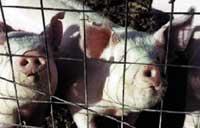Observe animals to know the human being

To find the causes and healings of human diseases and to be able to understand the functioning of the body, the Greeks began to use animals. They, however, were fortunate because they did not have to endure the prohibition of opening up human bodies. Therefore, during the validity of the prohibitions, the observation of animals and bodies of animals in the research work has been a constant duty. However, until the time of Resurrection, with Leonardo Da Vinci, the scientific use of animals was not systematic. The Italian described the anatomy of many animals and compared them to man. XIX. In the last years of the twentieth century, scientific research with animals was generalized in Germany and France.
Thanks to the research carried out with animals in the laboratories, vaccines against rabies, smallpox, tetanus, insulin and some antibiotics could be found, the structure of DNA could be identified and advanced in treatments against other diseases.

For biomedicine it is essential to investigate with animals. In this way, in addition to knowing the functioning of the cells, the adoption of preventive, diagnostic and treatment measures is facilitated. Likewise, to determine what and how the effects of many biological and chemical substances can be, it is important to use experimental animals in laboratories without endangering human health.
New drugs or therapies are generally shown in biological models. These models can start from the realization of simulations in computers, continue rehearsing with cell cultures -in vitro- and end trials with animals -in vivo-. For the investigation of diseases, the decision of treatments or the adoption of preventive measures, in this type of models animals of different species have been used:
- Mice. They have been fundamental in the advances of immunology to know the cancer process and understand the aging process.
- Rats. They are used in endocrinological research models, in models in which hypertension and diabetes are studied and in the study of dental diseases.
- Rabbits. They are frequently used, especially in the study of immune, eye, and hearing conditions.
- Leases. They have been used in nutrition studies.
- Pigs. Despite their appearance, they physiologically resemble man very much. Because their heart is very similar to the human being, they are frequently used in the research of drugs to combat heart disease and in the investigation of skin diseases. In the face of organ transplants, the work that is being done lately with pigs is very advanced.
- Sheep. They have helped develop some vaccines, such as anti-antrax, and have been used in research that is working on kidney diseases.
- Fish in general. They have been used in research models of liver cancer, diabetes, immune system alterations, vision and heart disease.
- Primates. They were essential to get the polio vaccine; they are frequently used in malaria studies; heart disease, etc. In addition, they were fundamental in research to understand the compatibility of blood groups. Among the species, no one is closer to the human being than the highest primates, so they use them in the final tests of trials.
- Dogs. They are not very common in research, but have been used. The first kidney transplant was performed with a dog, the appearance of diabetes has been investigated very well in dogs, it has been used in research to make tools for people with hearing problems, etc.
- Cats. Like dogs, in laboratories are not very common, but they have been used to investigate visual problems and leukemia.
Measures of protection of animals

The use of animals in research raises ethical and philosophical problems. They are usually problems of difficult solution, since there are no objective ethical criteria. In society there is a certain agreement or consensus to not accept cruelty in itself. However, in laboratory work it is difficult to control it. Who decides what is and what is not cruelty? The objectives of the research? Methods used in research? What does cruelty depend on? Should we look at the number of animals used in the trials? To the type of experiment with animals? … it is possible to ask many more questions, but it does not serve for much, because there are differences in the “value” of animals from one culture to another, from one society to another, from one person to another.
However, since 1986 the international community has regulations for biomedical research with animals:
- The advancement of biological knowledge and the development of health and well-being implies experimenting with living animals….
- Mathematical models, computer simulations or in vitro tests will be prioritized.
- When they are relevant to the progress and health of knowledge, the experiments will be carried out with animals.
- The animals chosen for the experiments must be adequate and the smallest possible number of animals will be used.
- Researchers should not forget that animals feel, so they will be caused the least pain, suffering and stress possible.
- What damages the human being also affects the animal, so it tries to fix more on the suffering of the animals.
- Depending on what is approved in veterinary medicine, if techniques that can cause pain are used, sedation or anesthesia will be given.
- With respect to the previous article, if things were to be done differently, the decision would not be made only by researchers, for which a special commission will be organized.
- Once the experiments are finished, animals that remain in an irreversible situation or with chronic pain die.
- During their stay in the laboratory, animals will be taken care of.
Published in 7
Buletina
Bidali zure helbide elektronikoa eta jaso asteroko buletina zure sarrera-ontzian











